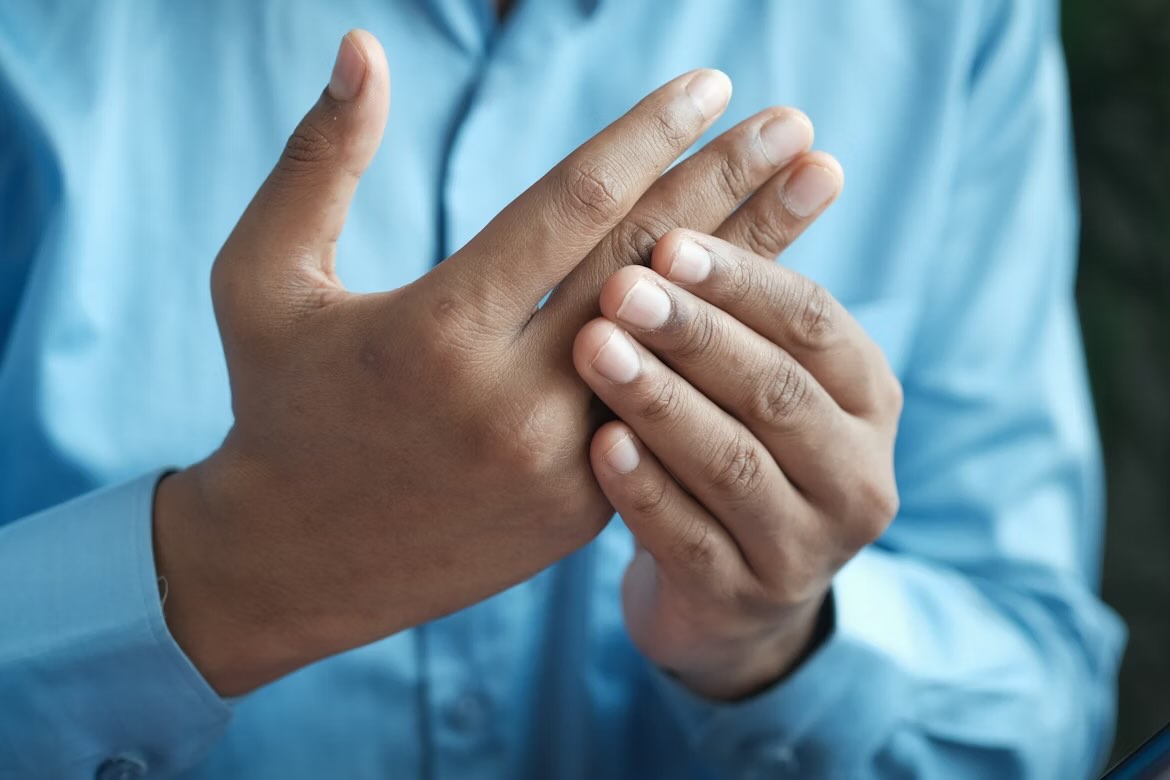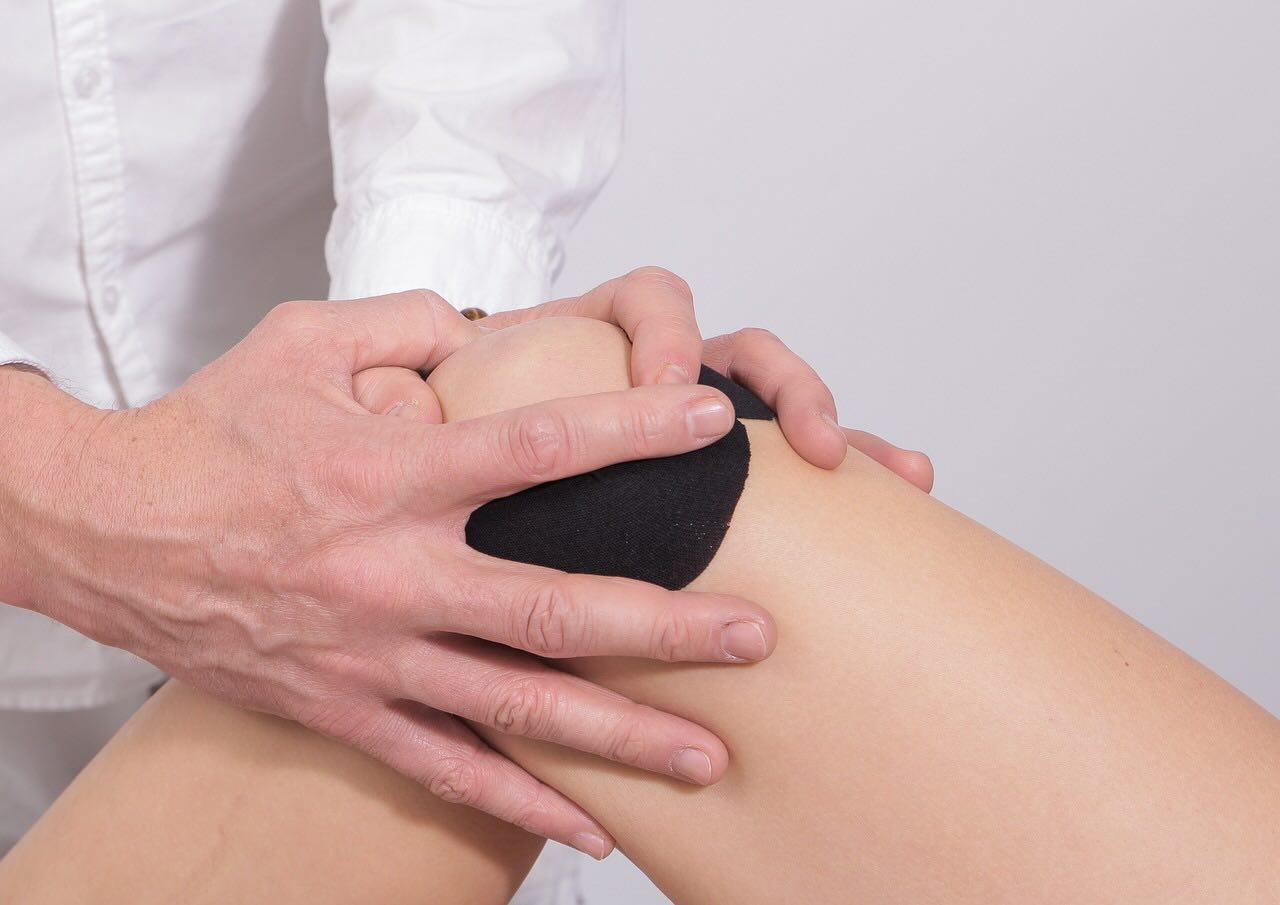What is the anatomy of the hip?
The hip is a ball and socket joint, consisting of the femoral head (ball) and the acetabulum (socket). The joint surfaces are lined with cartilage to allow smooth and painless motion. Around the edge of the acetabulum, there is a lip of cartilage, called the labrum. This cartilage helps keep the femoral head in place and absorbs energy when a force is applied to the hip.
There is a capsule that contains the joint and is filled with synovial fluid, which lubricates the joint.

Are you experiencing hip pain?
After a history and physical exam are completed, your physician may order imaging tests such as x-rays, CT, or MRI to confirm the diagnosis. There are many causes of hip pain, including:
- Osteoarthritis
- Rheumatoid arthritis
- Bursitis
- Labral tear
- Infection
- Developmental hip dysplasia
- Femoroacetabular impingement
- Fracture

What is hip arthroscopy?
Hip arthroscopy
- Hip arthroscopy is usually performed under general anesthesia (where you are asleep for the procedure) but can also be done under spinal anesthesia (numb from the waist down). First, the affected leg is placed in traction, meaning it will be pulled on, to separate the hip joint just enough to have space for the instruments. Then, the hip is injected with fluid to better visualize the joint, and incisions are made around the hip to insert a small camera and specialized instruments into the joint.
This procedure can be performed to treat multiple conditions, including:
- Labral tear
- Loose bodies
- Femoroacetabular impingement
- Hip joint infection
- Bursitis
- Snapping hip

Hip Arthroscopy with Labral Repair
If you’re dealing with a labral tear, hip arthroscopy with labral repair can make a real difference in your mobility and comfort. This procedure works to stabilize your hip by reattaching damaged cartilage, letting your joint move smoothly and painlessly. A healthy labrum doesn’t just support your hip—it also absorbs shock, helping protect your joint from wear and tear. With proper repair, you’re investing in a healthier, more stable hip that can keep you active and reduce the risk of arthritis down the road

Am I a candidate for hip arthroscopy?
- Patients who are candidates for hip arthroscopy are generally healthy and have a hip condition that does not require an open surgery. Conditions requiring hip arthroscopy are usually caused by sports injuries, repetitive use, or could be due to structural deformities (such as in femoroacetabular impingement).

What conditions cannot be treated with hip arthroscopy?
Hip arthroscopy is a valuable and effective procedure, but it does have limitations. Conditions that are not treatable with hip arthroscopy include:
- Hip osteoarthritis
- Severe deformities (as seen in hip dysplasia)
- Joint contracture
- Severe hip stiffness
These conditions are treated through other open surgeries.

How long is the recovery after a hip arthroscopy?
- Hip arthroscopy is usually performed as a day surgery, meaning you will go home the day of the surgery. Your surgeon may provide you with specific instructions for mobility, and you may need to use crutches for several days.
- You will work with a physical therapist to regain range of motion in the hip and build strength.
- You will be able to return to your normal daily activities after about 6 weeks. It takes 3-6 months before you can return to playing sports. It is important to regain full range of motion and adequate strength before discussing a return to sports.

Is hip arthroscopy painful?
- Pain is a normal part of the healing process, and you will be provided with medications to manage your pain. Acetaminophen, anti-inflammatory medications, and a short course of oral narcotics are generally adequate for pain control after hip arthroscopy.

What are the risks to undergoing hip arthroscopy?
Every surgical procedure involves the risk of complications. Complications related specifically to hip arthroscopy include:
- Cartilage damage from surgical instrumentation
- Nerve compression in the groin or leg due to positioning during surgery
- Infection
- Blood clots in the leg (deep venous thrombosis)

What is hip resurfacing?
Hip resurfacing is a procedure to treat hip osteoarthritis in select patients. The surface of the femoral head is cut away and replaced with a metal cap, and the acetabulum is shaved and a cup is inserted. This differs from a total hip arthroplasty, where the entire femoral head is cut away and a femoral stem and head are inserted.

How is it performed?
Hip resurfacing involves placing the patient under anesthesia, either general or spinal. An incision is created over the hip and the femoral head is dislocated. The femoral head is shaved away and replaced with a metal cap. The acetabulum is shaved with a reamer and a metal cap is impacted into place. The hip is then put back into place and the wound is closed

Who are good candidates for hip resurfacing?
Hip resurfacing is a procedure to treat hip osteoarthritis in a select number of patients. Ideal patients are younger than 60 years old and have strong, dense bone.
Conditions that are more amenable to total hip arthroplasty include:
- Severe osteoarthritis
- Hip conditions that have shortened the leg significantly
- Osteoporosis
- Severe hip deformities

What are the advantages and disadvantages of hip resurfacing compared to total hip arthroplasty?
If you’re considering hip resurfacing, it could be an excellent option if you want a bone-conserving solution that feels more like your natural hip. By keeping more of your own bone, resurfacing gives you a joint that’s stable and less likely to dislocate, even during high-impact activities. This can be a huge plus for staying active.
On the other hand, hip resurfacing isn’t a one-size-fits-all procedure. If you have arthritis or weaker bone quality, or if leg length discrepancies are a concern, total hip replacement might be the better route. In these cases, hip resurfacing won’t provide the customized correction that a traditional hip replacement surgery can. Choosing the right option ultimately depends on your specific needs and lifestyle, so it’s important to consult with an orthopedic surgeon to make the best choice.
The advantages of hip resurfacing include:
- Less bone is cut away
- Hip biomechanics are not altered significantly
- Lower likelihood of hip dislocation
The disadvantages of hip resurfacing include:
- May require larger incision
- Inability to correct limb length discrepancies

What are the risks to hip resurfacing?
- Hip fracture
- Infection
- Blood clots
- Excessive bleeding
- Nerve injury
- Metal ions entering the blood circulation

What is the recovery period after hip resurfacing?
- Patients are able to walk immediately after their surgery. You will require a physical therapy program to work on range of motion and strength after surgery.
- You can return to work performing light duties after several weeks. Return to physical activity is possible after 3-6 months. Patients should avoid high-impact physical activities such as running and skiing. Light to moderate physical activities such as walking, swimming, and playing golf are recommended.
Introduction

Have you suffered a torn rotator cuff? Have you had repeated shoulder dislocations? Have you had a shoulder injury that has not improved with pain medication and physical therapy? If so, then shoulder arthroscopy may be the right procedure for you. This surgical procedure involves using a small camera called an arthroscope and miniature shoulder instruments to diagnose and treat problems in the shoulder joint. Arthroscopic shoulder surgery is performed to diagnose and treat a number of diseases and injuries. The goals of arthroscopic shoulder surgery are to provide pain relief, improve range of motion, and to treat shoulder instability. Ideal candidates for shoulder arthroscopy include athletes, manual laborers, or any other individuals who have suffered a shoulder injury. Many shoulder injuries are treated with pain medication, physical therapy, and activity modification. However, if these modalities fail to provide pain relief or improve function, then surgical treatment would be the next step. It is important to note that only a qualified orthopedic surgeon can determine if shoulder arthroscopy is the right procedure for your individual needs.
The shoulder joint anatomy
The shoulder joint is a complex joint stabilized by multiple bones, tendons and ligaments. It is a very mobile joint that allows a large range of motion because it is a ball and socket joint. However, it requires multiple structures to work together and keep the joint stable. The complexity of the joint puts itself at risk for numerous shoulder problems.
The bones that make up the shoulder joint are the humerus (upper arm bone), scapula (shoulder blade) and clavicle (collar bone). The head of the humerus fits into the socket of the glenoid, which is a portion of the scapula. There is a lip of cartilage called the labrum that surrounds the glenoid and helps keep the head of the humerus in place. Another portion of the shoulder blade that has an important role is the acromion. The acromion hooks around the top of the shoulder and connects with the clavicle, forming the acromioclavicular joint.
There are several large and easily visible shoulder muscles that are responsible for moving the shoulder joint, such as the biceps and deltoid muscles. However, the most important muscles for the stability of the joint are the rotator cuff muscles. They enable the biceps and deltoid muscles to do the heavy lifting. The rotator cuff is comprised for four muscles: supraspinatus, infraspinatus, teres minor, and subscapularis. The rotator cuff tendons keep the head of the humerus stable throughout the shoulder’s range of motion.
Bursae are small sacs of fluid that help lubricate the numerous moving structures in the shoulder. With repetitive motion or due to an injury, the bursae can become inflamed and this inflamed tissue causes shoulder pain.
An injury to any structure in the shoulder can have a profound effect on function. The level of disability and treatment are dependent on which specific structures are injured and the severity of the injury. Shoulder pain can also limit range of motion and lead to frozen shoulder, where inflamed tissue causes severe shoulder stiffness.

What is shoulder arthroscopy?

Shoulder surgery can be performed in two ways:
Open surgery: making one large incision to look at the injured structures directly. Open surgery is more commonly performed for more complex surgeries such as shoulder replacements or shoulder fractures.
Open surgery: making one large incision to look at the injured structures directly. Open surgery is more commonly performed for more complex surgeries such as shoulder replacements or shoulder fractures.
A common procedure performed for shoulder injuries is shoulder arthroscopy. It is performed when nonsurgical options are either unsuccessful or provide insufficient pain relief. If you are experiencing persistent pain or instability despite physical therapy, rest, and anti-inflammatory medications, a surgery may be indicated for you.
Most shoulder arthroscopies are performed under general anesthesia, meaning you will be asleep. Your anesthetist may perform a nerve block to help alleviate pain during the surgery and for a short period afterwards.
The patient is usually positioned in an upright position, as if sitting in a beach chair or lying on their side, in the lateral decubitus position. Shoulder arthroscopy involves creating several small incisions around the shoulder. Sterile water is injected into the joint to expand the structures. A camera is inserted into the shoulder and specialized instruments are used to examine and repair structures. Depending on what repairs need to be performed, the surgery lasts between 30 minutes and 2 hours. Shoulder arthroscopy is a day surgery, meaning you will be able to go home shortly after the procedure is completed.

What shoulder problems can be treated with arthroscopic shoulder surgery?

Torn rotator cuff tendons
Shoulder instability or recurrent dislocations
Frozen shoulder
A diagnostic shoulder arthroscopy can also be performed if the cause of pain is unclear despite thorough non-invasive investigation.

What shoulder problems cannot be treated with arthroscopic shoulder surgery?

Osteoarthritis – This is wear and tear arthritis. It may require an open surgery to perform a total shoulder replacement.
Fractures – Not all shoulder fractures require surgery, but if surgery is indicated, it must be done as an open procedure. Shoulder fractures can be treated either with plates and screws, or with a partial shoulder replacement.

Is arthroscopic shoulder surgery painful?

Pain is a normal part of the recovery process. Your surgeon will prescribe you medications to relieve pain. Usually, over-the-counter pain medications and short-term narcotics are sufficient.
You may be given a sling of shoulder immobilize for comfort and to protect the repairs that were done.

How long is recovery from shoulder arthroscopy?

Recovery time varies depending on what repairs are done during shoulder arthroscopy. After a simple diagnostic shoulder arthroscopy, you can return to physical activity and driving after a couple of weeks. You may resume light duties at work after about one week.
For more complicated procedures, return to physical activity could take 3-6 months
It is important that you follow the recommendations of your orthopedic surgeon and physical therapist. You will be provided with a program to regain your shoulder strength and range of motion.

What are the risks of arthroscopic shoulder surgery?

Shoulder arthroscopy is a safe and commonly performed procedure. In rare occasions, complications may occur. These include:
Infection
Infection
Blood vessel injury
Blood vessel injury
If you notice any fever, redness at the surgical site, increased swelling of the arm, or pain that gets worse over time, then you should consult a physician.

Is shoulder arthroscopy a major surgery?

Arthroscopic shoulder surgery is usually a day surgery, meaning you will go home the same day of the procedure. There are also few risks, and the surgery does not take long to perform. However, it is still a complex surgery that requires knowledge and technical skill from your orthopedic surgeon and operating team.

Bankart repair

Shoulder dislocations occur usually due to trauma and involve the head of the humerus disengaging from the glenoid. This can cause damage to the labrum and even the bone of the glenoid, which leads to an increased risk of recurrent dislocations. The injured portion of the glenoid, whether it is the labrum or the bone that is damaged, is called a Bankart lesion. And fittingly, it is treated using the Bankart procedure.
Shoulder dislocations occur usually due to trauma and involve the head of the humerus disengaging from the glenoid. This can cause damage to the labrum and even the bone of the glenoid, which leads to an increased risk of recurrent dislocations. The injured portion of the glenoid, whether it is the labrum or the bone that is damaged, is called a Bankart lesion. And fittingly, it is treated using the Bankart procedure.

Rotator cuff repair

Rotator cuff tears can be the result of injury, overuse, or aging. Acute injuries are often amenable to repair as the muscle and tendon are still robust enough for sutures to hold them into place. In the case of chronic injuries, your surgeon will discuss with you whether a surgery is likely to help with pain and function. If a surgery is indicated, then a good outcome is likely.
Rotator cuff repairs are performed through shoulder arthroscopy. After a camera and specialized instruments are inserted, the shoulder is examined for other injuries that require treatment. After the rotator cuff tear is identified, small plugs with suture tails are inserted into humerus, around the humeral head. The suture tails are then woven through the torn tendon and are tightened to bring the tendon into contact with the bony surface of the humeral head.

Biceps tenodesis

Anatomy
The biceps is a muscle with two portions that originate in the shoulder. The short head attaches to the coracoid process (a finger-like projection on the scapula). The long head, which travels over the head of the humerus and attaches to the top of the glenoid. The longer biceps tendon travels over the shoulder and is at risk of being pinched by the acromion (the portion of the scapula that wraps around the top of the shoulder). With repetitive overhead movement, the pinched biceps tendon of the long head becomes frayed and inflamed. This leads to pain and loss of function.
Biceps tenodesis surgery is a two-step procedure to cut the tendon of the long head of the biceps and reattach it onto the humerus.
First, the surgeon performs a shoulder arthroscopy to confirm the diagnosis and to examine for any other injuries that require treatment. The tendon of the long head of the biceps is identified and cut.
The next step is to create a separate incision near the top of the humerus. The cut portion of the tendon is pulled out from this incision. The cut portion is reattached to the humerus with a button or a screw.

Acromioplasty

The acromion is a portion of the scapula (shoulder blade) that wraps around the top of the shoulder and attaches to the clavicle (collar bone). With repetitive or forceful overhead movements, the tendons in the shoulder can become pinched between the humerus and the acromion.
An acromioplasty is a procedure where the under surface of the acromion is shaved to prevent impingement on the tendons. It is performed through shoulder arthroscopy. After a camera and specialized instruments are inserted into the shoulder, the surgeon will look for other injuries that require treatment. Once the acromion is identified, a special instrument is used to shave off a thin portion under the acromion.



.png)

.png)











